Walking back segregation in Ferndale schools
One suburban Detroit school district is embracing school choice while taking steps to reduce segregated classrooms.
In Ferndale, an inner-ring suburb of Detroit, the city’s two elementary schools were mirror opposites: At Kennedy Elementary, 57 percent of the students were white and 27 percent black; at Roosevelt Primary, where most students lived in poverty, 54 percent were black, 32 percent white.
But last year, Ferndale’s school board decided to combine the two elementary schools. It was a tough decision that didn’t please everyone, the superintendent said. Some, including a few educators, warned that desegregating the schools would hurt the district because more white families would leave.
But Ferndale stuck by its decision. As the new school year opens, there are still two elementary school buildings: One is the K-2 “lower elementary” and the other is an “upper elementary” with grades 3-5. Young students will cycle through both schools.
The district did it, Superintendent Blake Prewitt said, because the board felt the best way to prepare children for a global society was to educate them in a diverse setting.
"I will give my community credit and school board credit. We didn't shy away by saying, 'There might be white flight so we won't” desegregate,” Prewitt said. "We really kept pushing on what's best for kids."
The next step: integrating Ferndale’s all-black high school with its other high school.
Ferndale’s University High School is comprised almost entirely of black students coming from Detroit through schools of choice. It was created in 2005 with grants and collegiate partners to be a college preparatory school and targeted students from Detroit, who had suffered through a rash of school closures and low graduation rates. University High is 96 percent black, with just two white students last year among its 400-plus student body.
Meanwhile, at Ferndale High School, which has not been available to choice students, blacks were 56 percent of the student body last year, while the white population stood at 30 percent.
The district already has moved to merge some sports teams at University and Ferndale high schools.
Prewitt acknowledged that a few parents have told him they were leaving the district because they didn't want their children to go to school with African-American students from Detroit.
"It's socioeconomic, it's racial,” he said. “It's 'I don't want my students with those kids.' Or there's the perception that a certain population of kids is going to drag the education down so (parents) are prone to go somewhere for lack of a better term, where other kids look like (their) kids."
See what new members are saying about why they donated to Bridge Michigan:
- “In order for this information to be accurate and unbiased it must be underwritten by its readers, not by special interests.” - Larry S.
- “Not many other media sources report on the topics Bridge does.” - Susan B.
- “Your journalism is outstanding and rare these days.” - Mark S.
If you want to ensure the future of nonpartisan, nonprofit Michigan journalism, please become a member today. You, too, will be asked why you donated and maybe we'll feature your quote next time!


 Blake Prewitt, superintendent of Ferndale Public Schools, said the district’s decision this year to merge a majority white elementary school with one that is majority black is “what’s best for kids.”
Blake Prewitt, superintendent of Ferndale Public Schools, said the district’s decision this year to merge a majority white elementary school with one that is majority black is “what’s best for kids.”